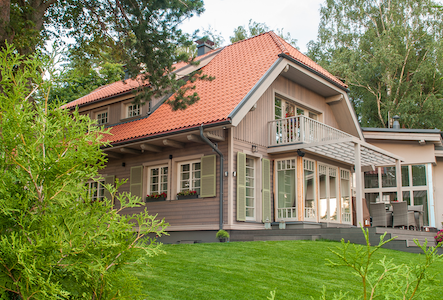Tile roofs

Tile roof — for elegant building design! It is a long lasting, safe, durable and cost-effective solution that will significantly increase the market value of the building if you would decide to sell it in the future.
Advantages of a clay and concrete tile roof
Tile roof has loads of advantages —it does not suffer from the elements of nature, does not rust and does not fade. Because of that, even after a number of years your roof will look like new. Tile roofs are available in a wide range of colours, so they will suit the demands of even the choosiest customers.
Longevity
Depending on the selected tile material, your roof will serve from 50 to 150 even years. A clay tile roof, when correctly installed according to the technological requirements and maintained, can serve up to 150 years, while a concrete tile roof — 50 to 100 years.
Fireproof
Both clay and concrete tile roofs are fireproof, thus providing additional security in your family house. Additionally, a clay tile roof does not absorb the heat from the Sun even in very hot days, so being indoors will not feel like being in a greenhouse or living in the tropics.
Cost-effective
Concrete tile roof price starts at 6 EUR/m². In addition, it should be factored in that when installing a tile roof, you will be saving on renovation and maintenance costs in the future. Even if one tile is cracked or otherwise damaged, it is much easier to replace it than, for example, a metal or shingle roof. You just need to replace the damaged tile with a new one. And such repair works will not take anything away from the quality of the roof, as would be the case with other types of roofing materials.
Weather resistance
Clay tile roofs and concrete tile roofs are very resistant to strong winds, rain and snow, which are becoming more and more common in Latvia, causing losses to both private and corporate owners, especially in the coastal area. Even if a tile has cracked, you need to replace only the damaged tile.
Noiseless
Both, clay and concrete tile roofs perfectly absorb the sound of even the heaviest rainfall.
Eco-friendly material
Neither concrete, nor clay tiles contain any substances harmful to nature. It is no wonder that clay tiles have been used for roofing since the ancient times and tile samples from Ancient Greece and Roman times can be viewed in museums all over the world.
Weight of a tile roof
Although it may initially seem that weight of a clay or concrete tile roof is very large (approx. 42 kg/m²), it should be taken into account that modern roof structures and technologies have developed considerably and weight is not a problem at all.
If a building has just been built, its roof trusses should be able to bear any type of roofing. In addition, it should be factored in that the roof trusses and roofing must be able to withstand the weight of a chimney sweeper or a roofer when maintenance or repairs are required.
It is also possible to reinforce of the roof trusses of buildings that were built some time ago.
Load bearing capacity of a tile roof
Snow and wind create the greatest load on a roof, which together account for about 76 % of the total load affecting a roof. Roof trusses, including rafters, lathing, ties, posts and struts, etc., represents only 11 % of the total roof weight. By contrast, the roofing alone represents only 13 %. In addition, a tile roof is resistant to deformation, so there is no need to worry about it bending inwards.
Mounting of tile roof
Installation of the tile roof is relatively simple. There is a good reason why it is one of the most favourite materials of roofers around the world. In addition, during its useful life any damaged part of a tile roof can be replaced easily, quickly and quite cheaply.
Cost
Clay and concrete tile roof cost depends on the roof area, complexity of roof trusses and, of course, the material chosen.
The exact roofing costs can be determined by examining the building and its design.
